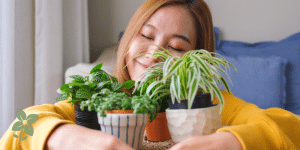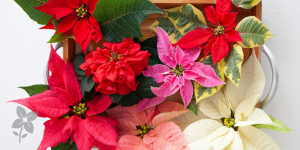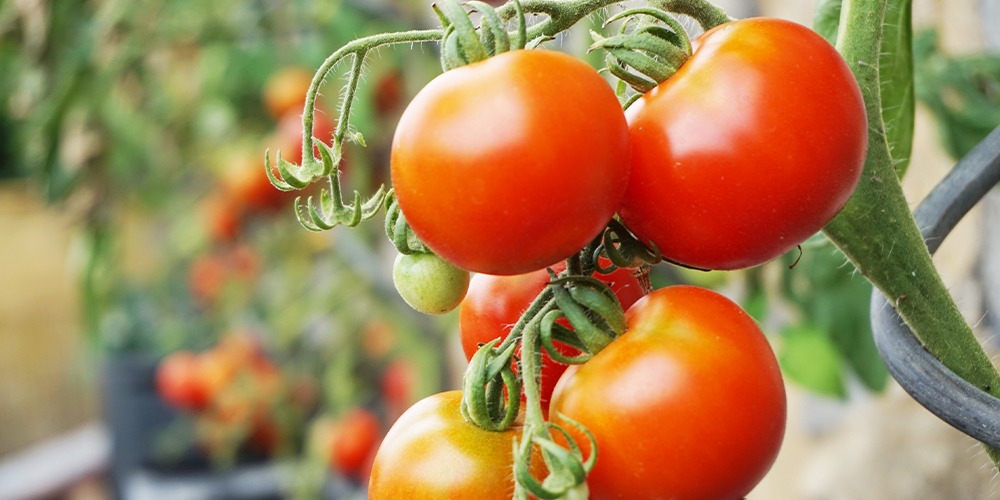
Growing tomatoes from seed is how many people get started with gardening. It’s an experience that can lead to tons of tasty tomato recipes, but sometimes it can be a surprising and often challenging experience for new gardeners.
It’s not that tomatoes are difficult to grow from seed, but they do require quite a bit of care and attention. Because tomatoes produce so much fruit in such a short time, they need tons of water, nutrients, and heat for a great crop.
Questions to Ask Yourself Before Buying Tomato Seeds
Here are some questions to ask yourself, what to look for when choosing tomatoes to grow from seed, and some tips for growing, harvesting, and preserving tomatoes. Once you’ve read through this guide to tomatoes, you’ll be ready for a successful growing season!
Tomatoes are a fairly diverse family of plants. There are always new cultivars coming on to the market, and there is a nearly endless choice of variety when to grow from seed. So, it’s a good idea to ask yourself these three questions before picking up the first pack of tomato seeds you see.
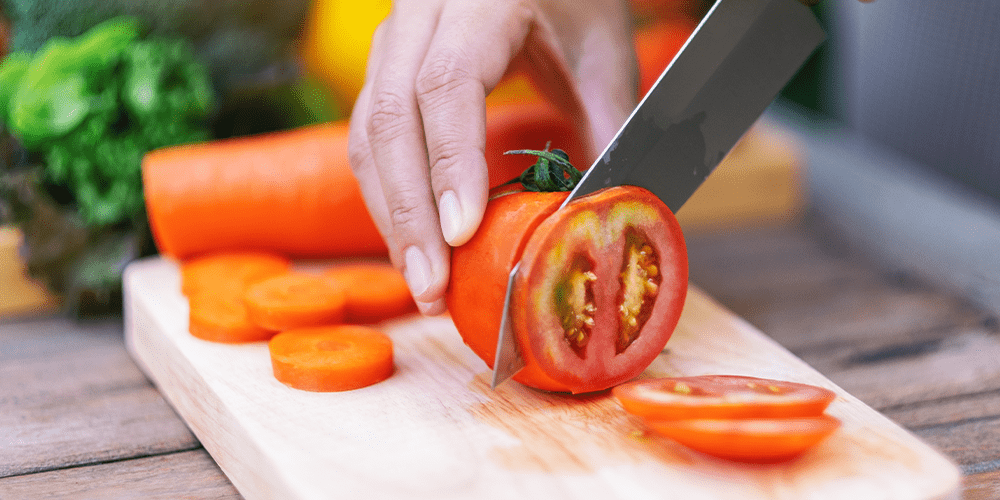
What do you want to do with your tomatoes?
How you want to use your tomatoes should be your first guideline for choosing seeds.
If you want tomato slices as big as your hand for stacking on sandwiches, you’ll want to grow beefsteaks from seed. If you want a few slightly smaller slices per sandwich, look for slicers.
If you want to make spaghetti sauce, ketchup, tomato paste, or can your tomatoes for use in recipes all winter, then plum or Roma varieties (sometimes called “sauce tomatoes”) are your best bet because they usually have denser flesh and fewer seeds.
If you want to toss a handful of small tomatoes into your salads, or you’re hoping out that viral TikTok feta pasta recipe, then cherry or grape tomatoes are your best bet!
If you prefer less acidic tomatoes, try one of the many delicious yellow varieties. Yellow tomatoes are not to be confused with unripe tomatoes””they are just as sweet and flavourful as their red and orange counterparts!
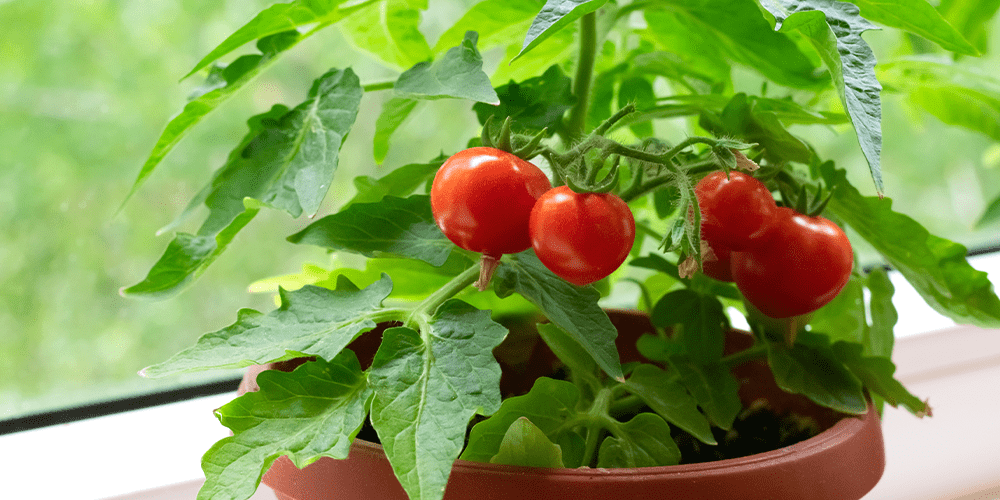
What kind of space do you have to grow tomatoes in?
The amount of space you have for growing tomatoes from seed should also guide your choices. In general, when growing from seed, determinate or bush tomatoes are best for growing in smaller spaces like pots, planters, or hanging baskets on your patio. They grow well in cages and should not be pruned at all, as they produce just one large flush of flowers and fruit during the year.
If you have a greenhouse or a larger space where you can stake tomatoes, then indeterminate varieties are a good choice. Indeterminate tomatoes will grow endlessly through the summer, producing a continuous supply of fruit. That means they can get well over 6 feet tall if you let them!
Do you want heirlooms or hybrids?
Deciding if you want to grow heirloom or hybrid tomatoes from seed is a little bit of personal preference and a little bit of soil science; here’s some info to help you decide.
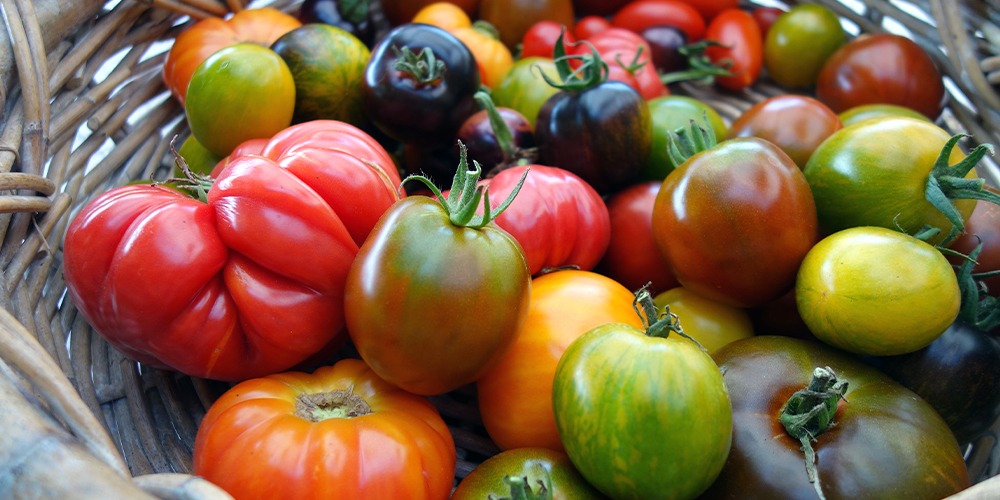
What’s the difference between heirlooms and hybrids?
Heirloom tomatoes have great taste and a long history. These tomatoes are usually “old-fashioned” in the sense that their seeds have been handed down for generations. An heirloom variety has been grown without crossbreeding for 40 years or more. These varieties were often developed initially for flavour. They usually produce smaller yields but often more luscious fruit than hybrids. With heirlooms, you can collect their seeds from your tomatoes for next year and keep their lineage going!
Hybrids were initially crossbred to create the ideal tomato for the grocery store: disease and pest resistant, high yield, firm flesh, and thick skin that will stand up to machine harvesting and being jostled in the store. But those aren’t the only goals they breed for these days. In the last couple of decades, breeders have also developed better flavour profiles in their hybrid tomatoes.
Hybrid tomatoes, in general, are more disease-resistant than heirlooms, so they’re a great option if you have had late blight in the past.
Whether heirloom or hybrid, how and when tomatoes are ripened and picked also affects their flavour. Homegrown, ripened-on-the-vine tomatoes will always taste better than tomatoes picked green and ripened with ethylene for the grocery store.
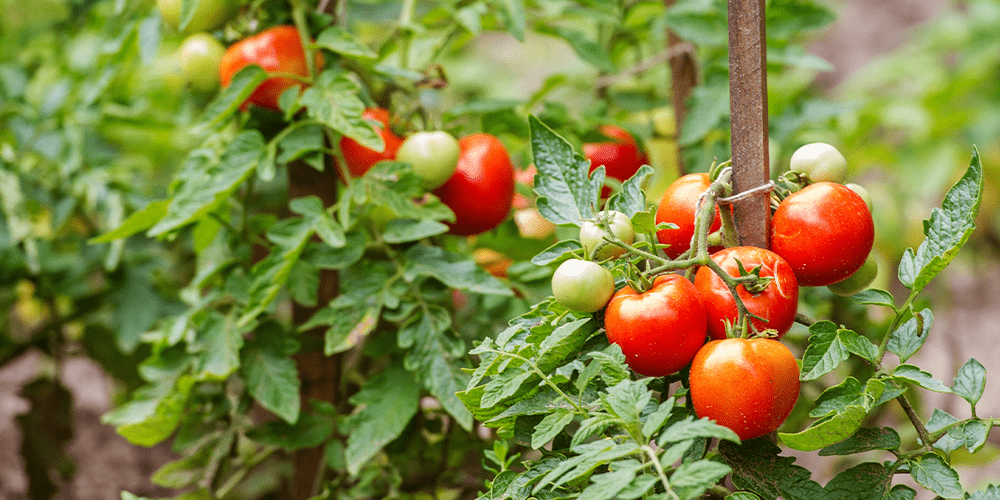
What to Look for When Buying Seed
Before you buy your tomato seeds, here are a few things to check on the seed package.
Days to Maturity
Edmonton’s growing season is 140 days, give or take 30, due to occasional early or late frost dates. The days to maturity estimate on the seed pack means the number of days it should take from when the seed is planted until it is ready to start flowering or setting fruit. So, in Edmonton, your best bet is to aim for tomatoes that mature in 100 days or less, so you can make sure they’re setting fruit for a few weeks before the first frost hits. If your tomatoes grow in a greenhouse, you can go a little longer, but don’t push it if you’re growing them outdoors.
Pro Tip: We recommend you start tomatoes on April 1st; 100 days from April first is July 10, so you should have tomatoes ready to eat by the 2nd or 3rd week of July.
If you’re growing multiple kinds of tomatoes, choose varieties that mature at different times so that you don’t have all of your tomatoes ripening all at the same time.
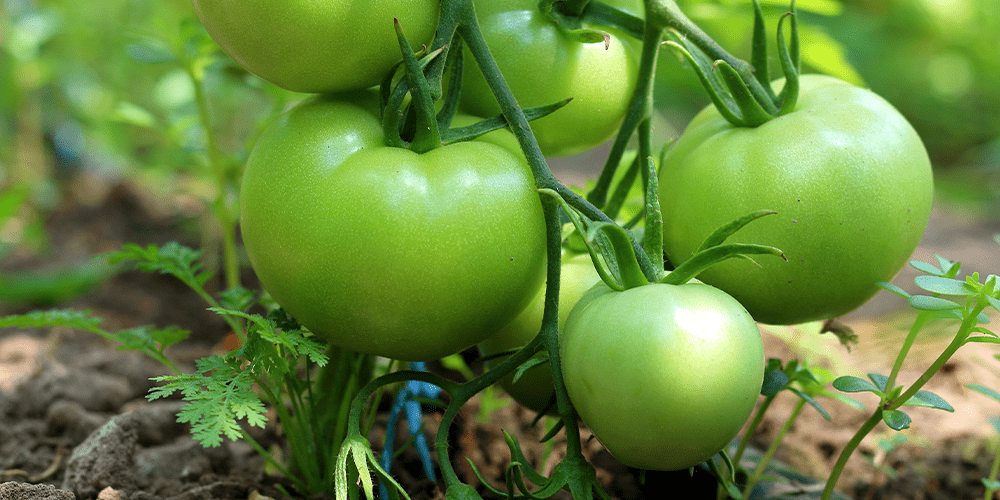
Disease Resistance
Late blight is a disease that affects tomatoes and potatoes. It is the same disease that caused the Irish potato famine. If you’ve had blight before, you’ll want to look for disease-resistant varieties. This usually means growing hybrid tomatoes from seed since most heirlooms aren’t disease-resistant.
Determinate or Indeterminate
Most packages will include this essential information. As we mentioned above, determinate varieties are great for growing with tomato cages or in hanging baskets on a small patio. Indeterminate varieties are better for larger plots; they will need to be staked and may grow exceptionally tall.
Packing Date
Most seed packages will say what year they were packed in. The longer it’s been since they were packed, the more likely you’ll have lower germination rates. Old seeds may still germinate well, but it’s not guaranteed.
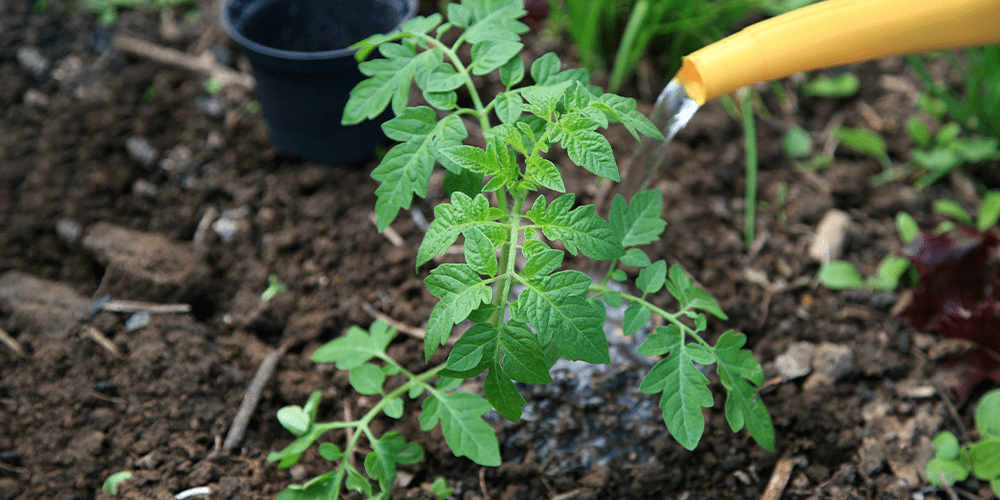
Tomato Growing Tips
- Start your tomato seeds on April 1st, or close to it.
- Use adjustable grow lights so you can keep them close to the tomato seedlings.
- Tomatoes need plenty of heat:
- Indoors: Fluorescent lights right above the seedlings provide the needed heat; LEDs don’t create much heat.
- Outdoors: Plant your tomatoes in the hottest part of your yard against a light-coloured wall that reflects heat. If you’re growing in pots, set them on pavers that absorb heat during the day and release it at night; that overnight heat is also necessary!
- You can use heat mats for germinating seedlings, but it’s not essential; you’ll be able to start them just fine without.
- Don’t transplant your tomatoes outside before May long weekend unless you’re prepared to move the pots inside or cover them with blankets and sheets at night.
- When transplanting outside, or up a pot size, you can bury tomato stems quite deep, and they’ll send out more roots from the stem, which can help them remain more stable.
- Use a complete fertilizer, meaning one with NPK plus micronutrients, or a tomato-specific fertilizer.
- Rotate your crops every year to break disease cycles.
- Use companion plants to either repel pests or attract pests to a different area of your garden.
- Use mulch under your tomatoes to retain moisture: grass clippings, leaves, and straw are great options.
- Don’t use the sprinkler on tomatoes; wet leaves are much more susceptible to fungal spot diseases.
- Tomatoes are high-maintenance, be consistent with watering, fertilizer, and supporting them with staking or cages.
- Don’t crowd your tomatoes when planting them out. They need good air circulation to stay healthy.
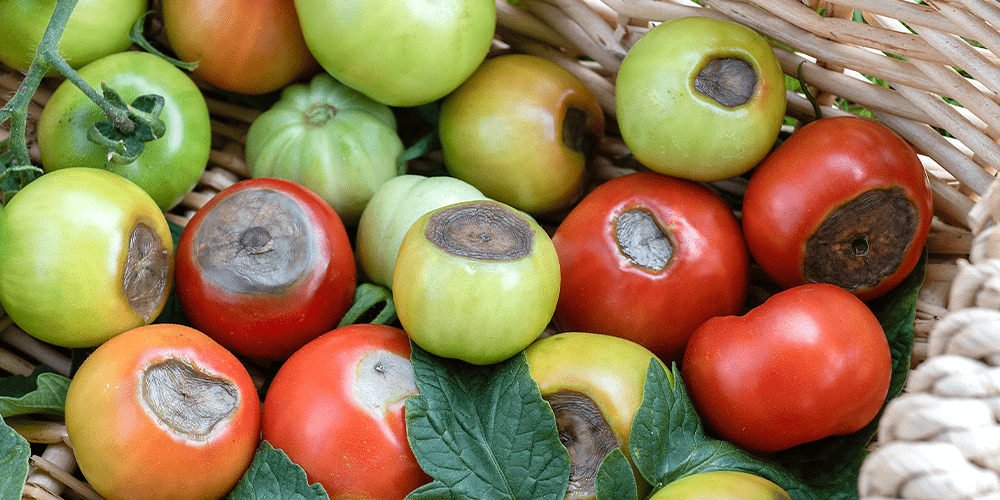
Dealing with Blossom End Rot
Blossom end rot is a result of tomato plants not absorbing enough calcium and boron from the soil. Most likely, your soil has enough of these nutrients in it, but they can’t absorb the nutrients if the soil is too dry. So generally, consistent watering will prevent blossom end rot.
If you are watering consistently and still have blossom end rot, you can add dolomite lime, lime calcium carbonate, gypsum, calcium oxide, or bone meal to your soil. You can also add crushed eggshells to your soil, but they break down too slowly to make a significant contribution to your calcium levels quickly. They’re a great addition to compost, but don’t rely on them to raise the calcium levels in your soil this season.
Harvesting Tips
Tomatoes should come off the vine easy; if you have to tug or use two hands, they’re not ripe enough to be picked yet. A ripe tomato should pop right off into your hand with just a gentle slight twist. If you have to harvest tomatoes before they’re ripe like at the end of the season, placing them in paper bags will help them ripen faster off the vine.
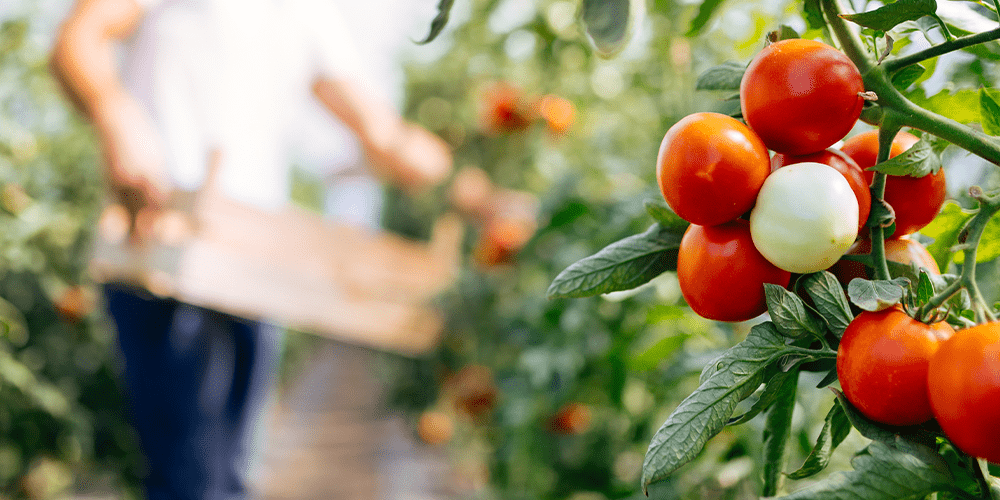
Preservation Tips
Preserving tomatoes can seem like an awful lot of work, but here’s a secret: You don’t have to blanch, skin, or de-seed, your tomatoes to preserve them. You can genuinely just puree your tomatoes whole before you preserve them or when you use them later. The skins and seeds puree into the mix well, and you won’t even notice that they were included; plus, you’ll have saved yourself a lot of time and energy!
If you want to remove the seeds from your tomatoes before preserving them, save some of those seeds and put them on a paper towel. Let them dry thoroughly, and then when you’re ready to plant, you can just plant the piece of the paper towel with seeds on it. Set the seed paper on top of the soil in your container, add a layer of soil over the top, and water it, and soon enough, you’ll have tomatoes growing. You can do this with any kind of tomato seeds.
Excited to start your tomato crop this year? Browse our selection of tomato seeds and starter plants at one of our two Edmonton garden centres: our flagship store in Sherwood Park or our new location at the Enjoy Centre in St Albert!


